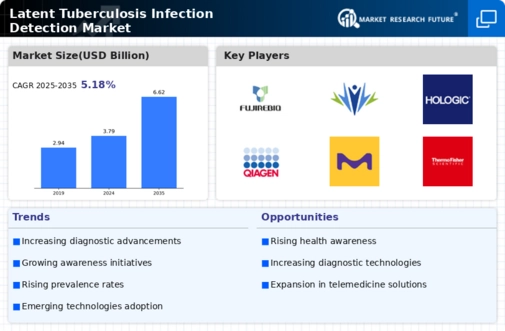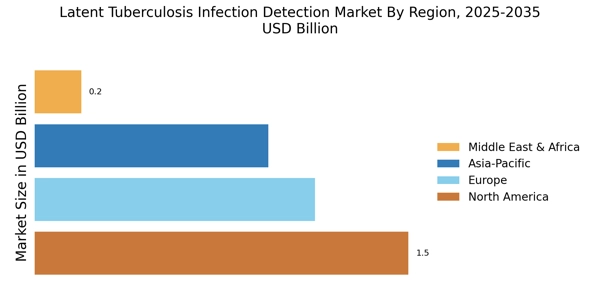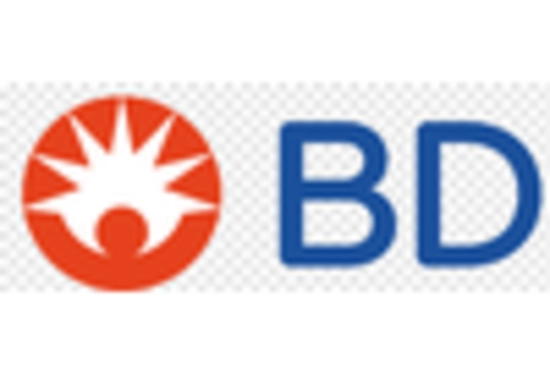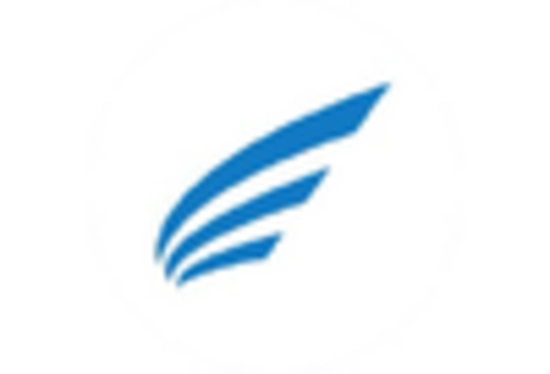Rising Incidence of Tuberculosis
The Latent Tuberculosis Infection Detection Market is significantly influenced by the rising incidence of tuberculosis cases worldwide. According to recent data, millions of individuals are estimated to be living with latent tuberculosis, which poses a risk of developing active disease. This alarming trend has prompted health authorities to prioritize tuberculosis control measures, thereby increasing the demand for effective detection methods. The World Health Organization has reported that approximately one-quarter of the global population is infected with latent tuberculosis, underscoring the urgent need for widespread screening and diagnosis. Consequently, healthcare systems are investing in advanced diagnostic technologies to identify and manage latent infections, driving growth in the market. The increasing awareness of tuberculosis as a public health threat further propels the need for innovative detection solutions.
Increased Awareness and Education
Increased awareness and education regarding tuberculosis and its latent form are pivotal drivers in the Latent Tuberculosis Infection Detection Market. Public health campaigns aimed at educating communities about the risks associated with latent tuberculosis are gaining momentum. These initiatives emphasize the importance of early detection and treatment, thereby encouraging individuals to seek testing. Healthcare providers are also receiving training to better understand the implications of latent tuberculosis and the necessity for effective screening. This heightened awareness is likely to lead to an increase in testing rates, as individuals become more informed about their health. Consequently, the demand for reliable diagnostic tools is expected to rise, further propelling the growth of the market as stakeholders respond to the need for enhanced detection capabilities.
Government Initiatives and Funding
Government initiatives and funding play a crucial role in shaping the Latent Tuberculosis Infection Detection Market. Various countries are implementing strategic plans aimed at tuberculosis elimination, which include substantial investments in research and development of diagnostic tools. These initiatives often focus on enhancing screening programs and improving access to testing in underserved populations. For instance, funding from governmental and non-governmental organizations is directed towards the development of cost-effective and efficient diagnostic methods. This financial support not only fosters innovation but also encourages collaboration among stakeholders in the healthcare sector. As a result, the market is likely to witness increased activity, with new products and technologies emerging to meet the growing demand for latent tuberculosis detection.
Technological Innovations in Testing Methods
The Latent Tuberculosis Infection Detection Market is experiencing a surge in technological innovations that enhance diagnostic accuracy and efficiency. Advanced molecular techniques, such as nucleic acid amplification tests, are becoming increasingly prevalent, allowing for rapid and precise detection of latent tuberculosis infections. These innovations not only improve patient outcomes but also streamline the testing process, making it more accessible. The integration of artificial intelligence in diagnostic tools further augments the capabilities of healthcare providers, enabling them to analyze data more effectively. As a result, the market is projected to grow significantly, with estimates suggesting a compound annual growth rate of over 5% in the coming years. This technological evolution is likely to reshape the landscape of tuberculosis detection, emphasizing the importance of timely and accurate diagnosis.
Emerging Markets and Healthcare Infrastructure Development
Emerging markets are becoming increasingly significant in the Latent Tuberculosis Infection Detection Market due to their expanding healthcare infrastructure. As countries develop their healthcare systems, there is a growing emphasis on improving diagnostic capabilities for various diseases, including tuberculosis. Investments in healthcare facilities and technology are facilitating better access to diagnostic services, particularly in regions with high tuberculosis prevalence. This trend is further supported by international partnerships and funding aimed at strengthening healthcare systems in developing nations. As a result, the market is likely to experience growth as these regions adopt advanced diagnostic methods to combat latent tuberculosis. The potential for market expansion in emerging economies presents opportunities for stakeholders to introduce innovative solutions tailored to local needs.


















Leave a Comment